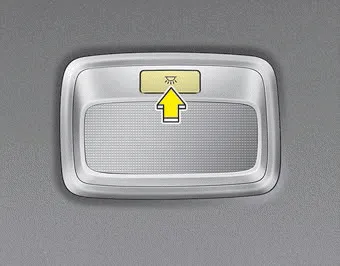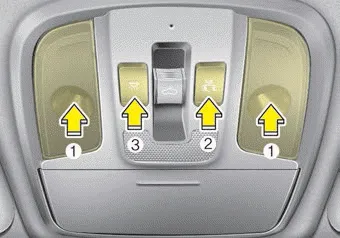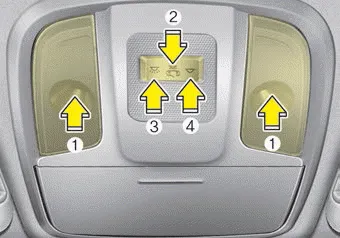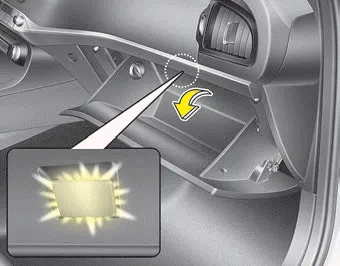Kia Stinger CK: Features of your vehicle / Interior lights
Contents:
- Automatic turn off function
- Map lamp
- Liftgate room lamp
- Vanity mirror lamp
- Glove box lamp
- Door courtesy lamp
Do not use the interior lights for extended periods when the engine is not running.
It may cause battery discharge.
WARNING - Interior Lights
Do not use the interior lights when driving in the dark. Accidents could happen because the view may be obscured by interior lights.
Automatic turn off function
The interior lights automatically turn off approximately 20 minutes after the ignition switch is turned off, if the lights are in the ON position.
If your vehicle is equipped with the theft alarm system, the interior lights automatically turn off approximately 5 seconds after the system is armed.
Room lamp

•
 : The light stays on at all times.
: The light stays on at all times.
Map lamp

■ Type A

■ Type B
• Press the lens (1) to turn ON the map lamp.
To turn the map lamp OFF press the lens (1) again.
• (2)
 : DOOR mode
: DOOR mode
- The map lamp and room lamp come on when a door is opened. The lamps go out
after approximately 30 seconds.
- The map lamp and room lamp come on for approximately 30 seconds when doors are
unlocked with a transmitter or smart key as long as the doors are not opened.
- The map lamp and room lamp will stay on for approximately 20 minutes if a door
is opened with the ignition switch in the ACC or LOCK/OFF position.
- The map lamp and room lamp will stay on continuously if the door is opened with
the ignition switch in the ON position.
- The map lamp and room lamp will go out immediately if the ignition switch is changed
to the ON position or all doors are locked.
- To turn off the DOOR mode, press the DOOR button (2) once again (not pressed).
✽ NOTICE
The DOOR mode and ROOM mode can not be selected at the same time.
Front Room Lamp:
• Type A
 (3): Press this switch to turn the
front and rear room lamps on and off.
(3): Press this switch to turn the
front and rear room lamps on and off.
• Type B
 (3): Press this switch to turn the
front and rear room lamps on.
(3): Press this switch to turn the
front and rear room lamps on.
 (4): Press this switch to turn the
front and rear room lamps off.
(4): Press this switch to turn the
front and rear room lamps off.
Liftgate room lamp

The liftgate room lamp comes on when the liftgate is opened.
The liftgate room lamp comes on as long as the liftgate lid opens. To prevent unnecessary battery drain, close the liftgate lid securely after using the liftgate room.
Vanity mirror lamp

Opening the lid of the vanity mirror will automatically turn on the mirror light.
* The actual sunvisor lamp in the vehicle may differ from the illustration.
CAUTION - Vanity mirror lamp
Always have the switch in the off position when the vanity mirror lamp is not in use. If the sunvisor is closed without the lamp off, it may discharge the battery or damage the sunvisor.
Glove box lamp

The glove box lamp comes on when the glove box is opened.
To prevent unnecessary battery drain, close the glove box securely after using the glove box.
Door courtesy lamp

The door courtesy lamp comes ON when the door is opened to assist entering or exiting the vehicle. It also serves as a warning to passing vehicles that the vehicle door is open.
Other information:
Kia Stinger (CK) 2018-2023 Owner's Manual: Side Airbag (SAB) Module
Description and operation Description Installed inside the front seat, the side airbags (SAB) protect the driver and front passenger from danger in the event of a side crash. The SRSCM determines deployment of side airbag based on Side Impact Sensor (SIS) signal. Never attempt to measure the circuit resistance of the airbag module (squib) even if you are using the specified tester.Kia Stinger (CK) 2018-2023 Owner's Manual: Rear Driveshaft Assembly
Repair procedures Removal 1. Remove wheel nuts, wheel and tire (A) from hub. Tightening torque: 107.9 - 127.5 N·m (11.0 - 13.0 kgf·m, 79.6 - 94.0 lb·ft) Be careful not to damage the wheel nuts when removing the wheel and tire (A).Categories
- Manuals Home
- Kia Stinger Owners Manual
- Kia Stinger Service Manual
- Automatic turn off function
- Map lamp
- Liftgate room lamp
- Vanity mirror lamp
- Glove box lamp
- Door courtesy lamp
- New on site
- Most important about car


